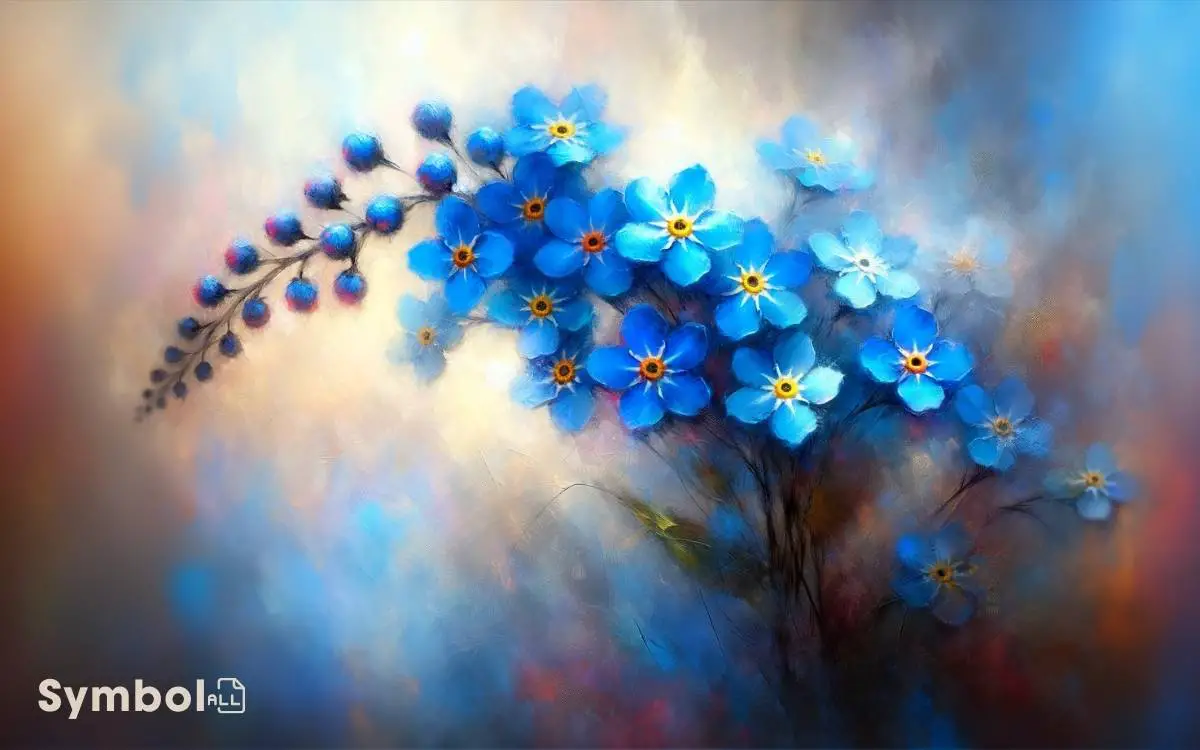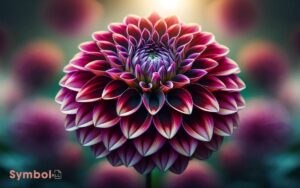What Flower Symbolizes Missing Someone? Forget-Me-Not!
The Forget-Me-Not flower is your answer if you’re looking to symbolize missing someone. This small, yet powerful bloom stands for memory, love, and a spiritual connection that endures despite distance or time apart.
Originating from a rich tapestry of myths and legends across German, Greek, Medieval Europe, Norse, and Celtic cultures, it’s become a universal symbol of faithful love and undying memories.
Each variety, from Myosotis sylvatica to Myosotis alpestris, offers a unique hue and adaptation, contributing to its versatile symbolism. As it bridges hearts across distances, exploring its varieties and stories will reveal deeper layers of emotional significance.

Key Takeaways
The Language of Flowers
The language of flowers, known as floriography, provides a nuanced means for expressing complex emotions and messages without the need for words. In this intricate system, specific flowers and their colors represent distinct sentiments and messages.
When you’re looking to convey a feeling of missing someone, floriography guides you towards selecting the appropriate bloom that encapsulates your emotions accurately.
It’s not merely about the choice of flower, but also the hue, the arrangement, and sometimes even the number of blooms that contribute to the depth of your message.
This method allows for a personalized and thoughtful way to communicate feelings that might be challenging to express verbally. Understanding this language equips you with the ability to convey profound emotional states elegantly and subtly.
History of the Forget-Me-Not
You’ll find the Forget-Me-Not’s history is as intricate as its delicate bloom. This section unpacks the flower’s origin myths, shedding light on how its poignant name and symbolism emerged across various cultures.
Moreover, you’ll explore its cultural significance, revealing the depth of its impact on art, literature, and collective memory over centuries.
Origin Myths Explored
Delving into the history of the forget-me-not, myths and legends offer a fascinating glimpse into its origins, revealing how this small flower has symbolized remembrance and love through the ages.
| Culture | Myth | Significance |
|---|---|---|
| German | A knight fell into a river while picking these flowers for his beloved, crying out ‘Forget me not!’ as he drowned. | Eternal remembrance |
| Greek | The goddess Artemis was said to have transformed a nymph into the flower to escape Apollo’s advances. | Enduring love |
| Medieval Europe | It was believed that wearing the flower would guarantee a loved one’s loyalty during long separations. | Fidelity and hope |
| Norse | Legend suggests the gods gave the flower its name as a token of memory in the afterlife. | Eternal memory |
| Celtic | Druids regarded it as a symbol of a lasting bond between the earthly and the spiritual. | Spiritual connection |
These narratives highlight the flower’s deep-rooted association with memory, love, and spiritual continuity.
Cultural Significance Unveiled
Exploring the cultural significance of the forget-me-not reveals its profound impact on societies throughout history, embodying themes of remembrance, love, and spiritual connection.
This diminutive yet striking flower has been a symbol in folklore and tradition across various cultures, often associated with enduring love and memory. This flower’s resilience and ability to thrive in challenging conditions have also made it a representation of strength and hope. In particular, the dandelion as a symbol of release is widely recognized, as its seeds are often blown away with a wish, symbolizing letting go and embracing new beginnings. Its universal charm and deep-rooted meanings make it a cherished emblem in various traditions and personal expressions.
In medieval Europe, it was believed that wearing a forget-me-not could guarantee that the wearer’s loved one would keep them in their thoughts.
Similarly, in Victorian England, the flower became a coded message in the language of flowers, signifying faithful love and undying memories.
Its botanical name, Myosotis, derives from the Greek words for ‘mouse’s ear,’ reflecting the shape of its petals, further illustrating the meticulous attention paid to its naming and its subsequent ingrained significance in cultural traditions.
Symbolism Across Cultures
Understanding the symbolism of flowers across cultures reveals a captivating diversity in the ways different societies express the sentiment of missing someone.
Here’s an in-depth exploration:
- Asia: In many Asian cultures, the Chrysanthemum symbolizes lamentation and longing, often used in rituals to honor ancestors and the deceased.
- Europe: The Forget-Me-Not, with its delicate blue blossoms, serves as a universal emblem of remembrance and true love across various European traditions.
- North America: Native tribes associate the White Trillium with departure and absence, using it in ceremonies to invoke the spirits of those who are no longer present.
- Middle East: The Desert Rose, resilient yet beautiful, represents enduring love and the hope of reunion despite separation by vast distances.
These examples highlight the nuanced ways cultures globally utilize floral symbolism to articulate the complex emotions tied to missing someone.
The Legend Behind Its Name
How did the Forget-Me-Not acquire its poignant name, deeply intertwined with themes of memory and longing?
Its etymology traces back to a legend of medieval Germany. As the story goes, a knight and his lady were walking along the side of a river when he picked a bouquet of these blue blossoms for her.
Suddenly, he fell into the water due to the weight of his armor. Before being swept away by the river, he threw the flowers to his love, shouting ‘Forget me not!’
This tragic tale encapsulates the essence of the flower’s name, symbolizing enduring love and remembrance. The name itself serves as a plea and promise, echoing through time to remind us of connections that withstand even the most insurmountable separations.
Varieties and Characteristics
Did you know that the Forget-Me-Not flower comes in various species, each with its own unique characteristics, ranging from color variations to distinct growing habits?
If you’re delving into the world of these symbolic flowers, understanding their varieties can enrich your appreciation for them.
Here’s a closer look:
- Myosotis sylvatica – Known as the woodland forget-me-not, this species thrives in damp, shady areas and features bright blue flowers.
- Myosotis scorpioides – Preferring wet environments, these are often found along streams, bearing sky-blue to pink flowers.
- Myosotis arvensis – The field forget-me-not prefers dry conditions, showcasing smaller, pale blue blooms.
- Myosotis alpestris – The alpine forget-me-not is known for its intense blue flowers, thriving in high-altitude, rocky terrains.
Each variety carries the essence of remembrance, yet their distinct traits cater to different gardening or natural settings.
Color Meanings Explained
As you delve into the world of flowers symbolizing the feeling of missing someone, it’s essential to understand how color interpretations can vary and the profound emotional impact these hues can have.
Each color carries specific meanings, influenced by cultural, historical, and personal contexts, shaping the message you wish to convey. Recognizing these nuances allows you to choose flowers that accurately express your feelings of longing and affection.
Color Interpretations Vary
Within the domain of flower symbolism, the interpretation of colors can greatly vary, directly influencing the message conveyed when you select a bloom to express feelings of missing someone.
- Red: Traditionally associated with love and passion, red can also signify a deep longing or desire for reunion.
- White: Often symbolizing purity and innocence, white blooms can represent the pure, earnest nature of your missing feelings.
- Yellow: While commonly linked to joy and friendship, in some cultures, yellow flowers may suggest a desire for a return to a joyful state once shared.
- Blue: Known for its calming effects, blue flowers can convey a message of peace and the hope for a serene reunion.
Choosing the right color requires understanding these nuanced interpretations to accurately express your sentiments.
Emotional Impact of Hues
Exploring the emotional impact of hues requires an understanding of how specific colors can evoke distinct feelings and responses in individuals.
Colors aren’t just visual stimuli; they’re deeply intertwined with psychological reactions and cultural associations, impacting mood and behavior.
| Color | Emotion | Context |
|---|---|---|
| Red | Passion, Urgency | Stimulates, commands attention, signifies love |
| Blue | Calmness, Trust | Invokes peace, serenity, often seen as reliable |
| Yellow | Happiness, Alert | Energizes, promotes warmth, cautionary signal |
Understanding the nuanced emotional triggers of these colors allows you to grasp their significance in various contexts, including floral arrangements.
When choosing flowers to symbolize missing someone, consider the hues that best convey your feelings and the message you wish to impart.
This knowledge empowers you to select blooms that resonate on a deeper emotional level, making your gesture even more meaningful.
In Literature and Art
In literature and art, flowers often serve as potent symbols for missing someone, deeply embedding this sentiment into various forms of creative expression.
Here’s how:
- Poetry: Poets utilize floral imagery to evoke the transient nature of presence and absence. A wilted flower, for instance, metaphorically represents the fading memory of a loved one.
- Paintings: Artists often depict certain flowers to convey longing. A solitary bloom in a vast landscape can symbolize isolation and the desire for reunion.
- Novels: Flowers in literature can mark significant moments of separation or loss, serving as a physical reminder of a character’s absence.
- Performing Arts: In plays and films, the presentation of a specific flower can foreshadow a character’s longing or commemorate those they’ve lost.
Each of these artistic expressions employs flowers to articulate complex emotions associated with missing someone, offering nuanced insights into human experiences.
Incorporating in Bouquets
Moving beyond artistic representations, let’s examine how specific flowers can be purposefully selected for bouquets to convey the sentiment of missing someone.
Forget-me-nots, with their delicate blue petals, are a classic choice, symbolizing true love and remembrance. They’re often paired with white roses, which represent innocence and purity, enhancing the bouquet’s message of deep, untainted longing.
Incorporating sprigs of lavender can add a layer of meaning, as lavender is associated with silence, calmness, and a personal connection.
When selecting these flowers, consider their freshness and color intensity to guarantee the bouquet vividly expresses your feelings.
Opt for a balanced arrangement where each flower’s significance complements the others, creating a harmonious message of longing and remembrance.
Gardening Tips
To guarantee your flowers symbolizing missing someone thrive, follow a seasonal planting schedule that aligns with their growth cycles.
You must also concentrate on soil preparation essentials, including the right pH balance and nutrient mix, tailored to your specific plants’ needs.
This groundwork is crucial for robust growth, allowing these symbolic blooms to flourish in your garden.
Seasonal Planting Schedule
Understanding the appropriate time to plant is crucial for a successful garden, as different plants thrive in various seasons due to their unique growth cycles and climate requirements.
To optimize your planting schedule, consider the following:
- Spring Planting: Focus on frost-resistant plants early in the season. As the soil warms, shift to your summer bloomers.
- Summer Planting: Ideal for heat-loving plants. Make sure they’re well-hydrated and plant in the evening to avoid shock.
- Autumn Planting: Great for perennials and bulbs that will bloom in spring. It’s also the time to sow cool-season vegetables.
- Winter Planting: In milder climates, you can plant hardy greens and flowers. Otherwise, plan and prepare for spring planting indoors.
Soil Preparation Essentials
After outlining the best times for planting different types of plants, it’s important to focus on preparing your soil. This foundation is essential for healthy plant growth. Begin by evaluating your soil’s texture and drainage capabilities.
If it’s too clayey, incorporating organic matter like compost can improve aeration and drainage. Conversely, sandy soils benefit from added organic matter as well, which enhances water retention and nutrient availability.
Conduct a pH test to confirm the soil’s acidity or alkalinity matches the needs of your plants. Adjusting pH can involve adding lime to raise it or sulfur to lower it.
Finally, ensure your soil is free of weeds and debris, and consider a balanced, slow-release fertilizer to provide a steady supply of nutrients.
Occasions for Giving
In the domain of expressing emotions, choosing the appropriate flower for different occasions can greatly convey feelings of missing someone with precision and depth.
When you’re contemplating the right time to present a flower that symbolizes missing someone, consider these occasions:
- Departures: Whether it’s a farewell party or moving away for a new job, a carefully selected flower can express your sentiment of missing them ahead.
- Anniversaries: On the anniversary of a significant date, like the passing of a loved one, flowers can serve as a heartfelt reminder of your longing and remembrance.
- Long-Distance Relationships: Marking milestones or simply as a surprise, flowers can bridge the gap between distances.
- After a significant life event: Providing comfort after a friend or family member has gone through a challenging time can show your support and convey that they’re missed.
Each occasion demands a thoughtful selection, ensuring the message of missing someone is conveyed with sincerity and depth.
Companion Plants
While exploring the emotional significance of flowers in various situations, it’s important to contemplate how companion plants can enhance their meaning and impact.
Companion plants, when paired thoughtfully, can intensify or complement the primary flower’s message.
For instance, pairing forget-me-nots, which symbolize remembrance and love, with white lilies, representing purity and renewal, creates a nuanced expression of longing mixed with hope for new beginnings.
It’s vital to take into account the growing conditions, blooming cycles, and color harmonies of these plants to make sure they thrive together and convey the intended message effectively.
Additionally, understanding the symbology of each plant allows you to craft a garden or bouquet that resonates deeply with the emotions you wish to express, making the act of missing someone profoundly more meaningful.
Preserving Memories
Preserving and capturing memories stands as an essential technique in the art of expressing longing through flowers, allowing you to hold onto moments of profound emotional significance.
When you’re missing someone, the act of preserving a flower that reminds you of them can serve as a tangible link to your memories together.
Here’s how you can do it:
- Pressing: Place flowers between parchment paper and press them in a heavy book for 7-10 days.
- Drying: Hang flowers upside down in a dark, dry place for several weeks until completely dehydrated.
- Encasing in Resin: Create a permanent keepsake by encasing dried flowers in clear resin.
- Photography: Capture the beauty of the flower in high-definition photographs for digital preservation.
Each method offers a unique way to cherish and remember your loved ones through the symbolic language of flowers.
Forget-Me-Nots in Weddings
Shifting focus to the domain of matrimonial celebrations, forget-me-nots serve as a poignant emblem of enduring love and memory when incorporated into wedding ceremonies and receptions.
You’ll often find these delicate blooms adorning bridal bouquets, boutonnieres, and centerpieces, where they symbolize the couple’s hopes to be forever remembered by each other. Their vibrant blue hue adds a splash of color, symbolizing fidelity and steadfast affection.
Floral designers recommend pairing forget-me-nots with complementary flowers to create visually appealing arrangements that convey depth and emotion.
Additionally, incorporating these blooms into wedding decor can create a sense of continuity, linking past memories with present celebrations and future hopes.
This thoughtful inclusion ensures that the essence of the day, steeped in love and remembrance, resonates long after the festivities conclude.
Myths and Folklore
Throughout history, various cultures have woven a rich tapestry of myths and folklore around flowers, attributing to them meanings that transcend their natural beauty.
These narratives often explore themes of love, loss, and remembrance, deeply entwining certain blooms with the human experience of missing someone.
- Greek Mythology: It’s rife with stories where flowers symbolize the bonds between separated lovers, with transformations capturing their eternal longing.
- Japanese Legends: They frequently employ blossoms to represent the fleeting nature of life and the sorrow of parting, highlighting the depth of human connections.
- Celtic Folklore: Here, flowers often serve as messages between the human world and the fae, embodying the yearning for what’s beyond reach.
- Native American Tales: Many stories use flora to signify the spirit’s persistence, embodying the memory and presence of those passed.
These narratives underscore flowers’ roles not just as symbols of beauty, but as vessels of profound human emotions and experiences.
Beyond Forget-Me-Nots
You’re already familiar with forget-me-nots as symbols of memory and affection, but there’s a broader palette of flowers that carry messages of longing and remembrance.
Moonflowers, for instance, bloom under the night sky, serving as a nocturnal messenger of love in absence.
Additionally, rosemary’s renowned for its remembrance qualities, while pansies symbolize a depth of thoughtful consideration, enhancing the ways you can express missing someone.
Moonflowers Nocturnal Messages
Moonflowers, with their nocturnal blooming, send powerful messages of longing and remembrance, distinguishing themselves from the more commonly referenced Forget-Me-Nots. Here’s why they’re special:
- Unique Blooming Time: They bloom at night, symbolizing messages and feelings that come alive in the quiet moments of reflection.
- Rapid Growth Cycle: Moonflowers can quickly go from seed to flower, representing the swift and unexpected ways in which we can miss someone.
- Large, Fragrant Blossoms: Their size and scent are potent reminders of presence and absence, mirroring the profound impact of a loved one’s absence.
- Symbol of Change: The flower’s life cycle, blooming at night and closing by morning, symbolizes the transient nature of life and memories, echoing the fleeting moments we cherish with those we miss.
Rosemarys Remembrance Qualities
Rosemary, often overshadowed by forget-me-nots, holds a profound significance in symbolizing remembrance. Its aromatic leaves serve as a timeless emblem of memory and fidelity.
This perennial herb, native to the Mediterranean region, has been revered throughout history not just for its culinary uses but for its symbolic meaning in various cultures.
In ancient times, rosemary was associated with the Greek goddess Aphrodite, symbolizing love and remembrance. During the Middle Ages, it was customary to carry rosemary sprigs at funerals to signify remembering the departed.
Its presence in wedding ceremonies, symbolizing loyalty and the promise of remembrance, underscores its deep-rooted significance.
Scientifically known as Rosmarinus officinalis, this herb’s resilience and evergreen nature further embody the enduring nature of memory and the strength of bonds that persist through time.
Pansys Thoughtful Symbolism
While pansies are often celebrated for their vibrant colors and delicate appearance, their symbolism extends far beyond mere aesthetics, representing thoughtful consideration and deep emotions for someone missed.
- Viola tricolor Variegation: This characteristic symbolizes the myriad emotions involved in missing someone, from sadness to hope.
- Resilience in Adversity: Pansies thrive in both spring and autumn, symbolizing enduring love and memory despite changing conditions.
- Historical Significance: In Victorian times, pansies were a secret symbol for lovers to express their longing in times when direct expression was forbidden.
- Color Spectrum: Each hue of pansy carries a distinct meaning, with purple representing nostalgia, yellow signifying longing, and white conveying thoughts of pure love.
Understanding pansies’ thoughtful symbolism enriches the gesture of gifting them, transforming a simple bouquet into a profound expression of missing someone dearly.
Conclusion
In wrapping up, it’s clear that forget-me-nots aren’t just another pretty face in the garden. They’re a powerful emblem of memory and longing, woven deeply into the fabric of various cultures and stories.
Remember, when it comes to expressing a feeling of missing someone, these flowers hit the nail on the head. Their delicate blooms and rich history make them a poignant choice for preserving memories, symbolizing those we hold dear in our hearts.
So, next time you’re looking to bridge the gap of distance, consider the timeless message carried by forget-me-nots.






